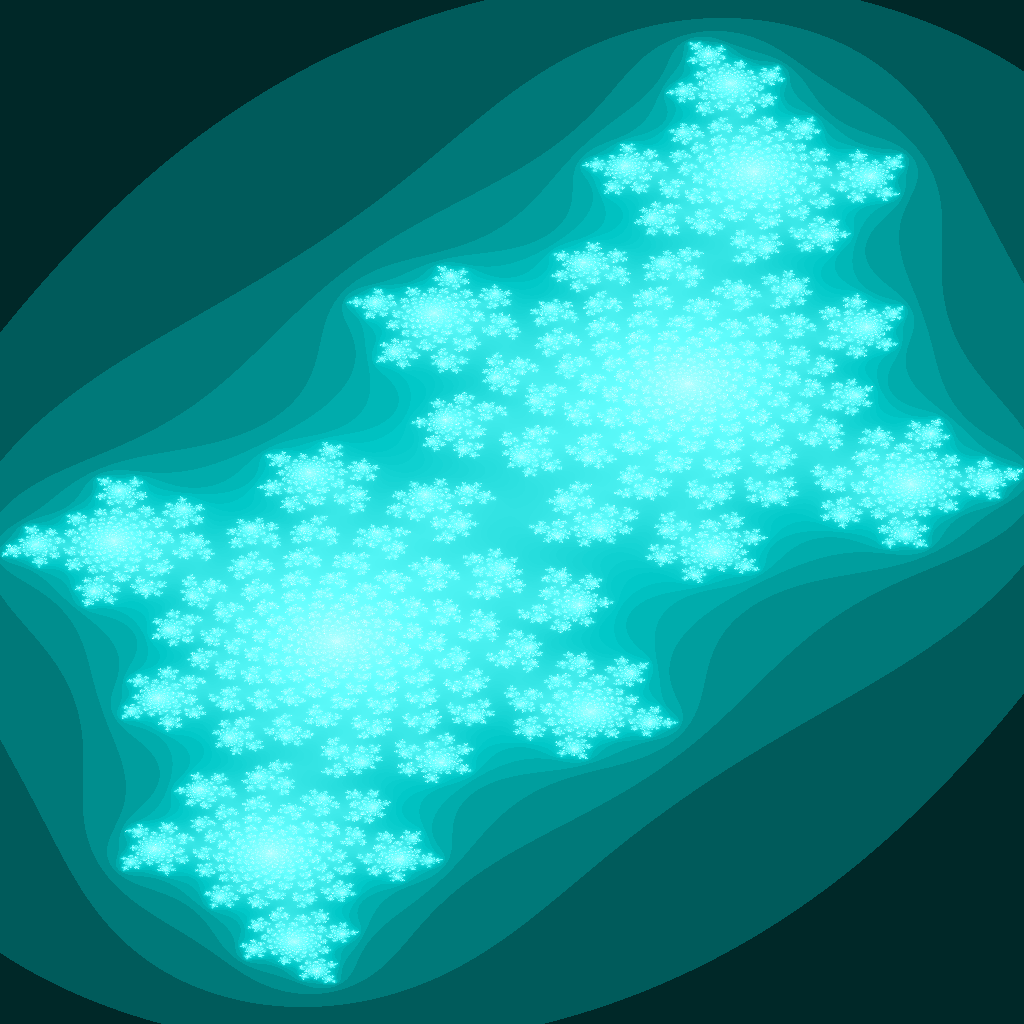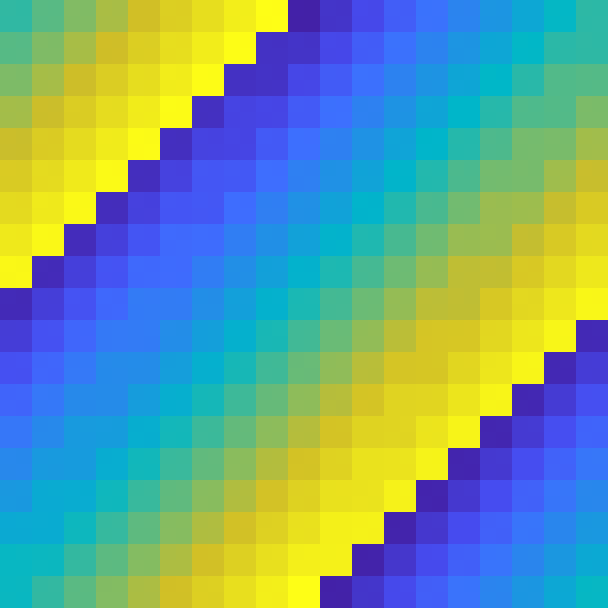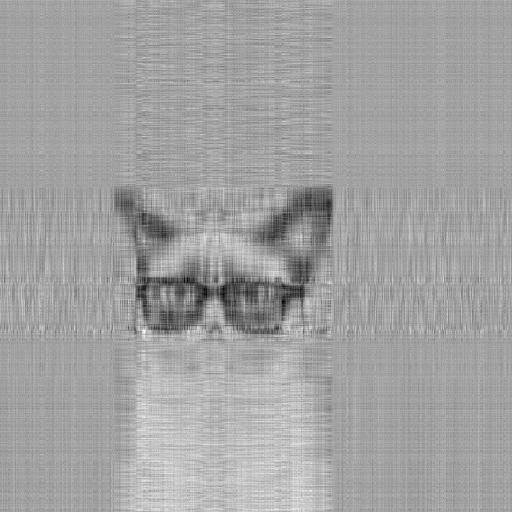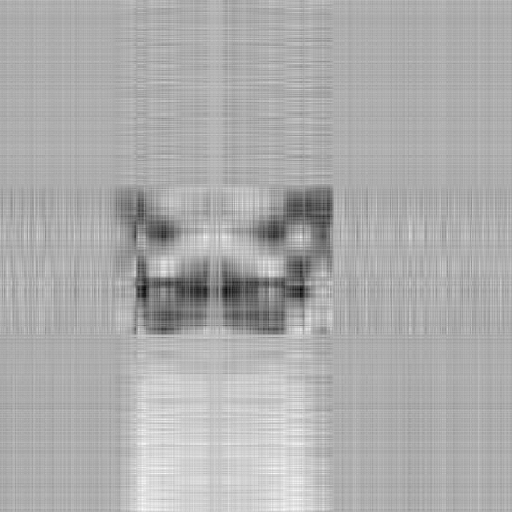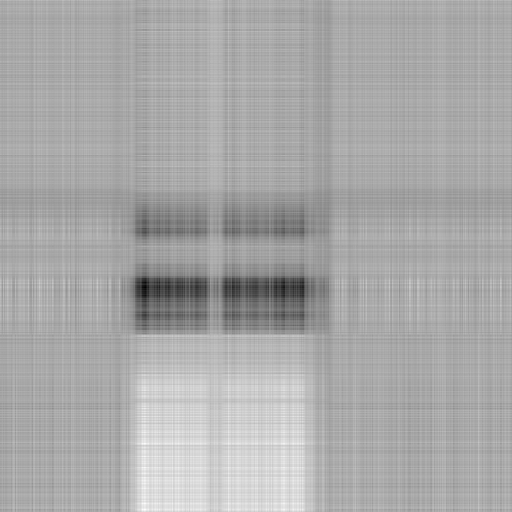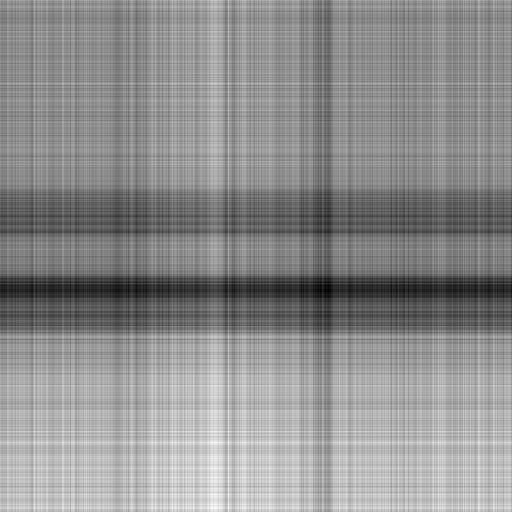A modern, C++20-native, single-file header-only dense 2D matrix library.
-
- creating matrices
- basic operations
- built-in functions
- clone -- matrix slicing
- astype -- converting matrix value type
- data -- accessing raw memory
- det -- matrix determinant
- operator
/= - inverse
- save matrix to images with colormap
- save/load bmp
- save png
- save/load
- load npy
- plot
- generating fractional image
- minus equal
- multiply equal
- plus equal
- prefix
- MORE TODO
- Common mathematical functions -- elementwise
- Common functions
- iterations
- element-wise apply
- head->tail iteration
- tail->head iteration
- row iteration
- reversed row iteration
- column iteration
- reversed column iteration
- diagonal iteration
- reversed diagonal iteration
- upper diagonal iteration
- reversed upper diagonal iteration
- lower diagonal iteration
- reversed lower diagonal iteration
- anti-diagonal iteration
- reversed anti-diagonal iteration
- upper anti-diagonal iteration
- reversed upper anti-diagonal iteration
- lower anti-diagonal iteration
- reversed lower anti-diagonal iteration
//your_source_code.cpp
#include "matrix.hpp"g++ -o your_exe_file your_source_code.cpp -std=c++20 -O2 -pthread -lstdc++fsPlease note std::thread is not enabled by default. If you prefer multi-thread mode, pass -DPARALLEL option to compiler, and add necessary link options.
std::filesystem is used, make sure corresponding library option is passed during link time (-lstdc++fs for g++).
Variadic macro __VA_OPT__ is used. It is officially supported since c++20(link1, link2), so the compiler must be compatible with c++20.
-
generating matrix
- creating a matrix of size
12 X 34:
feng::matrix<double> m{ 12, 34 };
- creating a random matrix of size
12 X 34, in range[0.0, 1.0]:
auto rand = feng::rand<double>(12, 34);
- creating a matrix of size
12 X 34, with all elements to be0:
auto zero = feng::zeros<double>(12, 34);
- creating a matrix of size
12 X 34, with all elements to be1:
auto one = feng::ones<double>(12, 34);
- and
ones_like:
auto another_one = feng::ones_like( one );- creating a matrix of size
12 X 34, with all elements to be uninitialized:
auto one = feng::empty<double>(12, 34);
- converting value types
auto one_fp32 = feng::empty<float>(12, 34); auto one_fp64 = one_fp32.astype<double>(); //
- creating a matrix of size
1 X (12*34), with all elements from0to12x34, then reshape to12 X 34:
auto one = feng::arange<double>(12*34); one.reshape( 12, 34 );
- loading matrix from a local txt file
./mat.txt, the delimiter can be either of,,\tor;, the line end is\n:
feng::matrix<double> mat; mat.load_txt( './mat.txt' );
- loading matrix from an opencv matrix instance with interface
from_opencv
cv::Mat M( 2, 2, CV_8UC3, cv::Scalar(0, 0, 255) ); std::cout << "OPENCV matrix:\n" << M << std::endl; feng::matrix<std::uint32_t> mat; mat.from_opencv( M ); std::cout << "Converted to feng::matrix:\n" << mat << std::endl;
This will produce output like:
OPENCV matrix: [ 0, 0, 255, 0, 0, 255; 0, 0, 255, 0, 0, 255] Converted to feng::matrix: 0 0 255 0 0 255 0 0 255 0 0 255However, to compile and link the code above, make sure to
- define the opencv guard by passing
-DOPENCVoption to the compiler (g++), - tell the compile where to find the opencv header files, for example, passing
pkg-config --cflags opencv4to the compiler (g++), and - tell the linker which libraries to link against, for example, passing
pkg-config --libs opencv4to the linker (g++). Or - compile and link in a single command, such as
g++ -o ./test_test -std=c++20 -Wall -Wextra -fmax-errors=1 -Ofast -flto=auto -funroll-all-loops -pipe -march=native -DPARALLEL -DOPENCV `pkg-config --cflags opencv4` -Wno-deprecated-enum-enum-conversion `pkg-config --libs opencv4` -pthread -lstdc++fs -Wl,--gc-sections -flto tests/test.cc
And to convert a matrix instance to opencv matrix:
cv::Mat m = mat.to_opencv( 3 );in whcih the parameter
3is for the image channels. By default this parameter is1, and up to 4 channels are allowed. - creating a matrix of size
-
others
feng::matrix<double> m{ 64, 256 };
m.save_as_bmp( "./images/0002_create.bmp" );
assert( m.row() == 64 );
assert( m.col() == 256 );
assert( m.size() == m.row() * m.col() );
auto const [r,c] = m.shape();
assert( r == m.row() );
assert( c == m.col() );
m.clear();
assert( 0 == m.row() );
assert( 0 == m.col() );feng::matrix<double> m{ 64, 256 };
for ( auto r = 12; r != 34; ++r )
for ( auto c = 34; c != 45; ++c )
m[r][c] = 1.0;
for ( auto r = 34; r != 45; ++r )
for ( auto c = 123; c != 234; ++c )
m(r, c) = -1.0;
m.save_as_bmp( "./images/0019_create.bmp" );feng::matrix<double> m{ 64, 256 };
int starter = 0;
double const keys[] = { 1, 2, 3, 4, 5, 6, 7, 8 };
for ( auto& x : m )
{
int val = starter++ & 0x7;
x = keys[val];
}
m.save_as_bmp( "./images/0000_access.bmp" );feng::matrix<double> m{ 64, 256 };
for ( auto r = 12; r != 34; ++r )
for ( auto c = 12; c != 34; ++c )
m[r][c] = 1.0;
m.save_as_bmp( "./images/0020_create.bmp" );created matrix m:
feng::matrix<double> n = m; //copying
n.save_as_bmp( "./images/0021_create.bmp" );copied matrix n:
n.resize( 63, 244 );
n.save_as_bmp( "./images/0022_create.bmp" );resized matrix n:
m.reshape( m.col(), m.row() );
m.save_as_bmp( "./images/0023_create.bmp" );reshaped matrix m:
feng::matrix<double> m{ 64, 256 };
std::fill( m.upper_diag_begin(1), m.upper_diag_end(1), 1.0 );
std::fill( m.diag_begin(), m.diag_end(), 1.0 );
std::fill( m.lower_diag_begin(1), m.lower_diag_end(1), 1.0 );
m.save_as_bmp( "./images/0000_slicing.bmp" );feng::matrix<double> n{ m, 0, 32, 0, 64 };
n.save_as_bmp( "./images/0001_slicing.bmp" );feng::matrix<double> p{ m, {16, 48}, {0, 64} };
p.save_as_bmp( "./images/0002_slicing.bmp" );meshgrid returns 2-D grid coordinates based on the coordinates contained in interger x and y.
auto const& [X, Y] = feng::meshgrid( 3, 5 );
std::cout << X << std::endl;
std::cout << Y << std::endl;This will produce
0 1 2
0 1 2
0 1 2
0 1 2
0 1 2
0 0 0
1 1 1
2 2 2
3 3 3
4 4 4
while the code below
auto const& [X, Y] = feng::meshgrid( 384, 512 );
X.save_as_bmp( "./images/0000_meshgrid_x.bmp", "grey" );
Y.save_as_bmp( "./images/0000_meshgrid_y.bmp", "grey" );generates two images
arange<Type>([start, ]stop, [step, ])Return evenly spaced row matrix within a given interval.
auto m = feng::arange<double>( 256*256 );
m.reshape( 256, 256 );
m.save_as_bmp( "./images/0000_arange.bmp" );For an normal matrix m
feng::matrix<double> m{ 64, 256 };
std::generate( m.begin(), m.end(), [](){ double init = 0.0; return [init]() mutable { init += 0.1; return init; }; }() );
m.save_as_bmp( "./images/0000_clip.bmp" );it can be transformed to range [0, 1] by applying sin on it
m = feng::sin(m);
m.save_as_bmp( "./images/0001_clip.bmp" );then this matrix can be clipped to range [0.1, 0.9]
auto const& cm0 = feng::clip( 0.1, 0.9 )( m );
cm0.save_as_bmp( "./images/0002_clip.bmp" );or even to range [0.4, 0.6]
auto const& cm1 = feng::clip( 0.4, 0.6 )( m );
cm1.save_as_bmp( "./images/0003_clip.bmp" );feng::matrix<double> m{ 64, 256 };
std::generate( m.begin(), m.end(), [](){ double init = 0.0; return [init]() mutable { init += 0.1; return init; }; }() );
m.save_as_bmp( "./images/0000_apply.bmp" );before apply:
m.apply( [](auto& x) { x = std::sin(x); } );
m.save_as_bmp( "./images/0001_apply.bmp" );after apply:
feng::matrix<double> m{ 64, 256 };
std::generate( m.begin(), m.end(), [](){ double init = 0.0; return [init]() mutable { init += 0.1; return init; }; }() );
m.save_as_bmp( "./images/0000_create.bmp" );feng::matrix<double> m{ 64, 256 };
std::generate( m.rbegin(), m.rend(), [](){ double init = 0.0; return [init]() mutable { init += 0.1; return init; }; }() );
m.save_as_bmp( "./images/0006_create.bmp" );feng::matrix<double> m{ 64, 256 };
std::generate( m.row_begin(17), m.row_end(17), [](){ double init = 0.0; return [init]() mutable { init += 0.1; return init; }; }() );
m.save_as_bmp( "./images/0001_create.bmp" );feng::matrix<double> m{ 64, 256 };
std::generate( m.row_rbegin(17), m.row_rend(17), [](){ double init = 0.0; return [init]() mutable { init += 0.1; return init; }; }() );
m.save_as_bmp( "./images/0003_create.bmp" );feng::matrix<double> m{ 64, 256 };
std::generate( m.col_begin(17), m.col_end(17), [](){ double init = 0.0; return [init]() mutable { init += 0.1; return init; }; }() );
m.save_as_bmp( "./images/0004_create.bmp" );
feng::matrix<double> m{ 64, 256 };
std::generate( m.col_rbegin(17), m.col_rend(17), [](){ double init = 0.0; return [init]() mutable { init += 0.1; return init; }; }() );
m.save_as_bmp( "./images/0003_create.bmp" );feng::matrix<double> m{ 64, 256 };
std::generate( m.diag_begin(), m.diag_end(), [](){ double init = 0.0; return [init]() mutable { init += 0.1; return init; }; }() );
m.save_as_bmp( "./images/0011_create.bmp" );feng::matrix<double> m{ 64, 256 };
std::generate( m.diag_rbegin(), m.diag_rend(), [](){ double init = 0.0; return [init]() mutable { init += 0.1; return init; }; }() );
m.save_as_bmp( "./images/0012_create.bmp" );feng::matrix<double> m{ 64, 256 };
std::generate( m.upper_diag_begin(17), m.upper_diag_end(17), [](){ double init = 0.0; return [init]() mutable { init += 0.1; return init; }; }() );
m.save_as_bmp( "./images/0007_create.bmp" );feng::matrix<double> m{ 64, 256 };
std::generate( m.upper_diag_rbegin(17), m.upper_diag_rend(17), [](){ double init = 0.0; return [init]() mutable { init += 0.1; return init; }; }() );
m.save_as_bmp( "./images/0008_create.bmp" );feng::matrix<double> m{ 64, 256 };
std::generate( m.lower_diag_begin(17), m.lower_diag_end(17), [](){ double init = 0.0; return [init]() mutable { init += 0.1; return init; }; }() );
m.save_as_bmp( "./images/0009_create.bmp" );feng::matrix<double> m{ 64, 256 };
std::generate( m.lower_diag_rbegin(17), m.lower_diag_rend(17), [](){ double init = 0.0; return [init]() mutable { init += 0.1; return init; }; }() );
m.save_as_bmp( "./images/0010_create.bmp" );feng::matrix<double> m{ 64, 256 };
std::generate( m.anti_diag_begin(), m.anti_diag_end(), [](){ double init = 0.0; return [init]() mutable { init += 0.1; return init; }; }() );
m.save_as_bmp( "./images/0017_create.bmp" );feng::matrix<double> m{ 64, 256 };
iag_rbegin(), m.anti_diag_rend(), [](){ double init = 0.0; return [init]() mutable { init += 0.1; return init; }; }() );
m.save_as_bmp( "./images/0018_create.bmp" );feng::matrix<double> m{ 64, 256 };
std::generate( m.upper_anti_diag_begin(17), m.upper_anti_diag_end(17), [](){ double init = 0.0; return [init]() mutable { init += 0.1; return init; }; }() );
m.save_as_bmp( "./images/0013_create.bmp" );feng::matrix<double> m{ 64, 256 };
std::generate( m.upper_anti_diag_rbegin(17), m.upper_anti_diag_rend(17), [](){ double init = 0.0; return [init]() mutable { init += 0.1; return init; }; }() );
m.save_as_bmp( "./images/0014_create.bmp" );feng::matrix<double> m{ 64, 256 };
std::generate( m.lower_anti_diag_begin(17), m.lower_anti_diag_end(17), [](){ double init = 0.0; return [init]() mutable { init += 0.1; return init; }; }() );
m.save_as_bmp( "./images/0015_create.bmp" );feng::matrix<double> m{ 64, 256 };
std::generate( m.lower_anti_diag_rbegin(17), m.lower_anti_diag_rend(17), [](){ double init = 0.0; return [init]() mutable { init += 0.1; return init; }; }() );
m.save_as_bmp( "./images/0016_create.bmp" );feng::matrix<double> m{ 64, 256 };
std::fill( m.diag_begin(), m.diag_end(), 1.1 );
m.save_as_bmp( "./images/0000_clone.bmp" );matrix m:
auto n = m.clone( 0, 32, 0, 64 );
n.save_as_bmp( "./images/0001_clone.bmp" );m slicing of [0:32, 0:64]:
n.clone( m, 32, 64, 0, 64 );
n.save_as_bmp( "./images/0002_clone.bmp" );m slicing of [32:64, 0:64]:
For a normal matrix such like
feng::matrix<double> m{ 64, 256 };
std::generate( m.begin(), m.end(), [](){ double init = 0.0; return [init]() mutable { init += 0.1; return std::sin(init); }; }() );
m.save_as_bmp( "./images/0000_astype.bmp" );There are many colors in its visualization.
astype can convert it to 3 colors:
m = m * 2.0;
auto const& mm = m.astype<int>();
mm.save_as_bmp( "./images/0001_astype.bmp" );feng::matrix<double> m{ 64, 256 };
m.save_as_bmp( "./images/0000_data.bmp" );original matrix
auto ptr = m.data();
for ( auto idx = 0UL; idx != m.size(); ++idx )
ptr[idx] = std::sin( idx*idx*0.1 );
m.save_as_bmp( "./images/0001_data.bmp" );after modification
feng::matrix<double> m{ 128, 128 };
std::generate( m.diag_begin(), m.diag_end(), [](){ double x = 0.9; return [x]() mutable { x+= 0.156; return x; }(); } );
double det1 = m.det();
double det2 = std::accumulate( m.diag_begin(), m.diag_end(), 1.0, []( double x, double y ){ return x*y; } );
std::cout << det1 << "\t:\t" << det2 << std::endl;generated output is
1069.00941294551 : 1069.0094129455
auto m = feng::rand<double>( 197, 197 );
auto n = m;
n /= 2.0;
m /= n;
m.save_as_bmp( "images/0000_divide_equal.bmp" );auto const& m = feng::rand<double>( 128, 128 );
auto const& n = m.inverse();
auto const& identity = m * n;
identity.save_as_bmp( "./images/0000_inverse.bmp" );Here we demonstrate how to save matrix to images with specified colormap. There are 18 builtin colormaps:
- autumn
- bluehot
- bone
- cool
- copper
- default
- gray
- hotblue
- hot
- hsv
- jet
- lines
- obscure
- parula
- pink
- spring
- summer
- winter
- gray
First we load the matrix from a '.txt' file
feng::matrix<double> m;
m.load_txt( "./images/Lenna.txt" );Then we can save this matrix to a '.bmp' file with default colormap:
m.save_as_bmp( "./images/0000_save_with_colormap_default.bmp" );The default image looks like:
m.save_as_bmp( "./images/0000_save_with_colormap_parula.bmp", "parula" );The parula image looks like:
m.save_as_bmp( "./images/0000_save_with_colormap_bluehot.bmp", "bluehot" );The bluehot image looks like:
m.save_as_bmp( "./images/0000_save_with_colormap_hotblue.bmp", "hotblue" );The hotblue image looks like:
m.save_as_bmp( "./images/0000_save_with_colormap_jet.bmp", "jet" );The jet image looks like:
m.save_as_bmp( "./images/0000_save_with_colormap_obscure.bmp", "obscure" );The obscure image looks like:
m.save_as_bmp( "./images/0000_save_with_colormap_gray.bmp", "gray" );The gray image looks like:
m.save_as_bmp( "./images/0000_save_with_colormap_hsv.bmp", "hsv" );The hsv image looks like:
m.save_as_bmp( "./images/0000_save_with_colormap_hot.bmp", "hot" );The hot image looks like:
m.save_as_bmp( "./images/0000_save_with_colormap_cool.bmp", "cool" );The cool image looks like:
m.save_as_bmp( "./images/0000_save_with_colormap_spring.bmp", "spring" );The spring image looks like:
m.save_as_bmp( "./images/0000_save_with_colormap_summer.bmp", "summer" );The summer image looks like:
m.save_as_bmp( "./images/0000_save_with_colormap_autumn.bmp", "autumn" );The autumn image looks like:
m.save_as_bmp( "./images/0000_save_with_colormap_winter.bmp", "winter" );The winter image looks like:
m.save_as_bmp( "./images/0000_save_with_colormap_bone.bmp", "bone" );The bone image looks like:
m.save_as_bmp( "./images/0000_save_with_colormap_copper.bmp", "copper" );The copper image looks like:
m.save_as_bmp( "./images/0000_save_with_colormap_pink.bmp", "pink" );The pink image looks like:
m.save_as_bmp( "./images/0000_save_with_colormap_lines.bmp", "lines" );The lines image looks like:
For sparse data such as particles, it is highly recommended to use colormap bluehot:
feng::matrix<double> m;
m.load_txt( "./images/star.txt" );
m.save_as_bmp( "./images/0001_star_bluehot.bmp", "bluehot" );The starry image generate is demonstrated below:
To load an image from a txt file, we can use .load_txt method:
feng::matrix<double> m;
m.load_txt( "./images/Lenna.txt" );
m.save_as_txt( "./images/0000_save_load.txt" );
m.save_as_binary( "./images/0000_save_load.bin" );
m.save_as_bmp( "./images/0000_save_load.bmp" );The image loaded is
feng::matrix<double> n;
n.load_txt( "./images/0000_save_load.txt" );
n.save_as_bmp( "./images/0001_save_load.bmp" );n.load_binary( "./images/0000_save_load.bin" );
n.save_as_pgm( "./images/0002_save_load.pgm" );Loading a matrix created by numpy is straightforward:
feng::matrix<double> mat;
mat.load_npy( "./images/64.npy");To load an image from a bmp file, we can use feng::load_bmp function, which will return an oject of type std::optional<std::array<feng::matrix<std::uint8_t>,3>>:
std::optional<std::array<matrix<std::uint8_t>,3>> load_bmp( std::string const& file_path ) {...}We first generate an image of Lenna:
feng::matrix<double> m;
m.load_txt( "./images/Lenna.txt" );
m.save_as_bmp( "./images/Lenna.bmp", "gray" );which looks like:
Then we can try to load it directly:
auto const& mat_3 = feng::load_bmp( "./images/Lenna.bmp" );
if successfull, ``mat_3with hold a channel-first image. To accessmat_3` we need to verify it is accessible first by:
if ( mat_3 )
{Then we can visualize its red channel:
(*mat_3)[0].save_as_bmp( "./images/0001_save_load_julia_red.bmp", "gray" );green channel:
(*mat_3)[1].save_as_bmp( "./images/0001_save_load_julia_green.bmp", "gray" );and blue channel:
(*mat_3)[2].save_as_bmp( "./images/0001_save_load_julia_blue.bmp", "gray" );It is possible to save matrix as a png file the same way as bmp
m.save_as_png( "./images/0000_save_with_colormap_default.png" );
m.save_as_png( "./images/0000_save_with_colormap_parula.png", "parula" ); feng::matrix<double> image;
image.load_txt( "images/Lenna.txt" );
image.save_as_bmp("images/0000_minus_equal.bmp", "gray"); double const min = *std::min_element( image.begin(), image.end() );
image -= min;
image.save_as_bmp("images/0001_minus_equal.bmp", "jet"); image -= image;
image.save_as_bmp("images/0002_minus_equal.bmp");plot is an alias name of save_as_bmp:
feng::matrix<double> m;
m.load_txt( "./images/Lenna.txt" );
m.plot( "./images/0000_plot_default.bmp" );m.plot( "./images/0000_plot_jet.bmp", "jet" );Having plot/save_as_bmp method implemented, it is convenient to plot a juliet set to an image.
The polynomial function is:
f_c(z) = z^n + c
Suppose we have the ranges of z, the x and y coordinates in a 2D image, the power n and the constant c, we can generate an image like this
auto make_julia_set( std::complex<double> const& lower_left, std::complex<double> const& upper_right, std::complex<double>const& cval, unsigned long const dim = 1024, unsigned long const iterations = 1024, unsigned long const powers = 2 )
{
std::complex<double> spacing_ratio{ (std::real(upper_right)-std::real(lower_left)) / static_cast<double>(dim),
(std::imag(upper_right)-std::imag(lower_left)) / static_cast<double>(dim) };
feng::matrix<std::complex<double>> cmat{ dim, dim };
for ( auto r = 0UL; r != dim; ++r )
for ( auto c = 0UL; c != dim; ++c )
cmat[r][c] = std::complex<double>{ static_cast<double>(r), static_cast<double>(c) };
auto const& converter = [&spacing_ratio, &lower_left, &upper_right, iterations, powers, &cval]( std::complex<double>& c )
{
std::complex<double> z = lower_left + std::complex<double>{ std::real(spacing_ratio)*std::real(c), std::imag(spacing_ratio)*std::imag(c) };
c = std::complex<double>{ static_cast<double>(iterations), 0 };
for ( auto idx = 0UL; idx != iterations; ++idx )
{
z = std::pow( z, powers ) + cval;
if ( std::abs(z) > 2.0 )
{
c = std::complex<double>{ static_cast<double>(idx), 0 };
break;
}
}
};
cmat.apply( converter );
return feng::real(cmat);
}where the lower_left and upper_right defines the size of the canvas, the cval is for the constant c, the dim gives the sampling density, the iterations gives the maximum value in the sampled positions, and the powers for the maximum order of the polinomial.
Then we are able to generate a series of the fractional images:
unsigned long const n = 32;
for ( unsigned r = 0; r != n; ++r )
for ( unsigned c = 0; c != n; ++c )
{
std::complex<double> zc{ double(r)/n*1.8-0.9, double(c)/n*1.8-0.9 };
auto&& mat = make_julia_set( std::complex<double>{-1.5, -1.0}, std::complex<double>{1.5, 1.0}, zc, 1024, 1024, 4 );
std::string file_name = std::string{"./images/julia_set_4/0001_julia_set_"} + std::to_string(r) + std::string{"-"} + std::to_string(c) + std::string{".bmp"};
mat.save_as_bmp( file_name, "tealhot" );
}A typical result image looks like this:
auto m = feng::rand( 127, 127 );
m *= m.inverse();
m.save_as_bmp("images/0001_multiply_equal.bmp"); feng::matrix<double> image;
image.load_txt( "images/Lenna.txt" );
image.save_as_bmp("images/0000_plus_equal.bmp", "gray"); double const mn = *std::min_element( image.begin(), image.end() );
double const mx = *std::max_element( image.begin(), image.end() );
image = (image - mn)/(mx - mn);
auto const& noise = feng::rand<double>( image.row(), image.col() );
image += 0.1*noise;
image.save_as_bmp("images/0001_plus_equal.bmp", "gray");auto const& m = feng::random<double>( 127, 127 );
auto const& pp = +m;
auto const& pm = -m;
auto const& shoule_be_zero = pp + pm;
shoule_be_zero.save_as_bmp("images/0000_prefix.bmp");Most common mathematical functions are supported as elementwise matrix operator. Here only sin and sinh are demonstrated
feng::matrix<double> m{ 64, 256 };
std::generate( m.begin(), m.end(), [](){ double init = 0.0; return [init]() mutable { init += 0.1; return init; }; }() );
m.save_as_bmp( "./images/0000_sin.bmp" );m = feng::sin(m);
m.save_as_bmp( "./images/0001_sin.bmp" );feng::matrix<double> m{ 64, 256 };
std::generate( m.begin(), m.end(), [](){ double init = 0.0; return [init]() mutable { init += 0.1; return init/500.0; }; }() );
m.save_as_bmp( "./images/0000_sinh.bmp" );m = feng::sinh(m);
m.save_as_bmp( "./images/0001_sinh.bmp" );auto const& m = feng::eye<double>( 128, 128 );
m.save_as_bmp( "./images/0000_eye.bmp" );auto const& m = feng::linspace<double>( 1, 10, 10 );
std::cout << "linspace<double>(1, 10, 10):\n" << m << std::endl;gives out an array of size 1 x 10:
linspace(1, 10, 10): 1 2 3 4 5 6 7 8 9 10
auto const& m = feng::linspace<double>( 1, 10, 10, false );
std::cout << "linspace<double>(1, 10, 10, false):\n" << m << std::endl;
gives out an array of size 1 x 9:
linspace(1, 10, 10, false): 1 1.89999999999999991 2.79999999999999982 3.69999999999999973 4.59999999999999964 5.5 6.40000000000000036 7.30000000000000071 8.20000000000000107 9.10000000000000142
And the prototype of linspace is:
matrix<T> linspace( T start, T stop, const std::uint_least64_t num = 50ULL, bool end_point=true )Calling magic method is quite straightforward:
std::cout << "Magic 3\n" << feng::magic( 3 ) << std::endl;
std::cout << "Magic 4\n" << feng::magic( 4 ) << std::endl;
std::cout << "Magic 5\n" << feng::magic( 5 ) << std::endl;
std::cout << "Magic 6\n" << feng::magic( 6 ) << std::endl;This will produce a series of magic matrices:
Magic 3
8 1 6
3 5 7
4 9 2
Magic 4
16 3 2 13
5 10 11 8
9 6 7 12
4 15 14 1
Magic 5
17 24 1 8 15
23 5 7 14 16
4 6 13 20 22
10 12 19 21 3
11 18 25 2 9
Magic 6
32 29 4 1 24 21
30 31 2 3 22 23
12 9 17 20 28 25
10 11 18 19 26 27
13 16 33 36 8 5
14 15 34 35 6 7
Also we can expand it a bit to do a better visualization:
unsigned long n = 38;
unsigned long pixs = 16;
auto const& mat = feng::magic( n );
feng::matrix<double> v_mat( n*pixs, n*pixs );
for ( auto r = 0UL; r != n; ++r )
for ( auto c = 0UL; c != n; ++c )
for ( auto rr = 0UL; rr != pixs; ++rr )
for ( auto cc = 0UL; cc != pixs; ++cc )
v_mat[r*pixs+rr][c*pixs+cc] = mat[r][c];
v_mat.save_as_bmp("./images/0001_magic.bmp");
This produces an image looks like:
feng::matrix<double> m;
m.load_txt( "./images/Lenna.txt" );
m.save_as_bmp( "./images/0000_conv.bmp", "gray" );Full 2D matrix convolution with zero-paddings is given by conv or conv2 :
feng::matrix<double> filter{3, 3, {0.0, 1.0, 0.0,
1.0,-4.0, 1.0,
0.0, 1.0, 0.0}};
auto const& edge = feng::conv( m, filter );
edge.save_as_bmp( "./images/0001_conv.bmp", "gray" );The convolution has three modes: valid, same, and full
The valid mode gives out convolution result without zero-paddings:
auto const& edge_valid = feng::conv( m, filter, "valid" );
edge_valid.save_as_bmp( "./images/0001_conv_valid.bmp", "gray" );The same mode returns the central part of the convolution result with zero-paddings, of the same size as the larger matrix passed to function conv
auto const& edge_same = feng::conv( m, filter, "same" );
edge_same.save_as_bmp( "./images/0001_conv_same.bmp", "gray" );full mode is the default mode:
auto const& edge_full = feng::conv( m, filter, "full" );
edge_full.save_as_bmp( "./images/0001_conv_full.bmp", "gray" );feng::matrix<double> m;
m.load_txt( "./images/Lenna.txt" );
m.save_as_bmp( "./images/0000_make_view.bmp" );auto const[r,c] = m.shape();
auto const& v = feng::make_view( m, {r>>2, (r>>2)*3}, {c>>2, (c>>2)*3} );
v.save_as_bmp( "./images/0001_make_view.bmp" );And creating new matrix from a view
auto new_matrix{v};
new_matrix.save_as_bmp( "./images/0002_make_view.bmp" );A matrix view has several methods, row(), col(), shape() and operator[]():
feng::matrix<double> n{ v.row(), v.col() }; // row() and col() of a matrix view
for ( auto r = 0UL; r != n.row(); ++r )
for ( auto c = 0UL; c != n.col(); ++c )
n[r][c] = v[r][c]; // accessing matrix elements using operator [], read-only
n.save_as_bmp( "./images/0003_make_view.bmp", "gray" );We first Load an image from hardisk and normalize it to range [0,1]
// load
feng::matrix<double> m;
m.load_txt( "./images/Teacher.txt" );
// normalize
auto const mx = *std::max_element( m.begin(), m.end() );
auto const mn = *std::min_element( m.begin(), m.end() );
m = ( m - mn ) / ( mx - mn + 1.0e-10 );
// take a snapshot
m.save_as_bmp( "./images/0000_singular_value_decomposition.bmp", "gray" );This image looks like:
Then we add some white noise to remove possible singularity in it:
// adding noise
auto const[r, c] = m.shape();
m += feng::rand<double>( r, c );
// record noisy matrix
m.save_as_bmp( "./images/0001_singular_value_decomposition.bmp", "gray" );The noisy image now looks like
We execute Singular Value Decomposition by calling function std::optional<std::tuple<matrix, matrix, matrix>> singular_value_decomposition( matrix const& ), or svd
// execute svd
auto const& svd = feng::singular_value_decomposition( m );If the svd is successfully, we can verify the accuricy by reconstructing the noisy image by matrix multiplications
// check svd result
if (svd) // case successful
{
// extracted svd result matrices, u, v w
auto const& [u, v, w] = (*svd);
// try to reconstruct matrix using u * v * w'
auto const& m_ = u * v * (w.transpose());
// record reconstructed matrix
m_.save_as_bmp( "./images/0002_singular_value_decomposition.bmp", "gray" );
The reconstructed image looks like:
One interesting application of SVD is data compression. In the code above, we use full rank to restore the original noisy image. However, we can select only 1/2 or 1/4 or even less ranks to approximate the original image. The code below demonstrates how:
auto dm = std::min( r, c );
auto factor = 2UL;
while ( dm >= factor )
{
auto new_dm = dm / factor;
feng::matrix<double> const new_u{ u, std::make_pair(0UL, r), std::make_pair(0UL, new_dm) };
feng::matrix<double> const new_v{ v, std::make_pair(0UL, new_dm), std::make_pair(0UL, new_dm) };
feng::matrix<double> const new_w{ w, std::make_pair(0UL, c), std::make_pair(0UL, new_dm) };
auto const& new_m = new_u * new_v * new_w.transpose();
new_m.save_as_bmp( "./images/0003_singular_value_decomposition_"+std::to_string(new_dm)+".bmp", "gray" );
factor *= 2UL;
}
}
else
{
std::cout << "Failed to execute Singular Value Decomposition for this matrix!\n";
}
When using 256 ranks, the reconstructed image lookes like:
When using 128 ranks, the reconstructed image lookes like:
When using 64 ranks, the reconstructed image lookes like:
When using 32 ranks, the reconstructed image lookes like:
When using 16 ranks, the reconstructed image lookes like:
When using 8 ranks, the reconstructed image lookes like:
When using 4 ranks, the reconstructed image lookes like:
When using 2 ranks, the reconstructed image lookes like:
When using 1 ranks, the reconstructed image lookes like:
We are able to pooling an image with function pooling( matrix, dim_row, dim_col, option ), where option can be either of mean, max, or min, if no option provided, then mean is applied.
For an normal image
feng::matrix<double> m;
m.load_txt( "./images/Lenna.txt" );
m.save_as_bmp( "./images/0000_pooling.bmp", "gray" );A 2X2 mean pooling looks like:
auto const& pooling_2 = feng::pooling( m, 2 );
pooling_2.save_as_bmp( "./images/0000_pooling_2.bmp", "gray" );And a 4X4 pooling is
auto const& pooling_4 = feng::pooling( m, 4 );
pooling_4.save_as_bmp( "./images/0000_pooling_4.bmp", "gray" );For hyterdyne pooling of 2X4
auto const& pooling_2_4 = feng::pooling( m, 2, 4 );
pooling_2_4.save_as_bmp( "./images/0000_pooling_2_4.bmp", "gray" );And 4X2
auto const& pooling_4_2 = feng::pooling( m, 4, 2 );
pooling_4_2.save_as_bmp( "./images/0000_pooling_4_2.bmp", "gray" );Also min pooling is possible
auto const& pooling_min = feng::pooling( m, 2, "min" );
pooling_min.save_as_bmp( "./images/0000_pooling_2_min.bmp", "gray" );And max pooling
auto const& pooling_max = feng::pooling( m, 2, "max" );
pooling_max.save_as_bmp( "./images/0000_pooling_2_max.bmp", "gray" );for a random matrix
auto const& m = feng::rand<double>( 64, 128);
m.save_as_bmp( "./images/0000_gauss_jordan_elimination.bmp", "gray" );auto const& n = feng::gauss_jordan_elimination( m ); //<- also `feng::rref(m);`, alias name from Matlab
if (n)
(*n).save_as_bmp( "./images/0001_gauss_jordan_elimination.bmp", "gray" );
else
std::cout << "Failed to execute Gauss-Jordan Elimination for matrix m.\n";after applying Gauss Jordan elimination, the matrix is reduced to a form of
We load a Lena from harddisk file ./images/Lenna.txt using function load_txt(std::string const&):
// initial matrix
feng::matrix<double> m;
m.load_txt( "./images/Lenna.txt" );
m.save_as_bmp( "./images/0000_lu_decomposition.bmp", "gray" );The loaded image lookes like below:
Then we scale this image to range [0,1] and add some uniform random noise to it (to remove singularity of the original image)
// adding noise
double mn = *std::min_element( m.begin(), m.end() );
double mx = *std::max_element( m.begin(), m.end() );
m = (m-mn) / (mx - mn + 1.0e-10);
auto const& [row, col] = m.shape();
m += feng::rand<double>( row, col );
m.save_as_bmp( "./images/0001_lu_decomposition.bmp", "gray" );The noised image lookes like:
we can do LU decomposition simply with std::optional<std::tuple<matrix, matrix>>lu_decomposition( matrix const& ) function
// lu decomposition
auto const& lu = feng::lu_decomposition( m );
if (lu)
{
auto const& [l, u] = lu.value();
l.save_as_bmp( "./images/0002_lu_decomposition.bmp", "jet" );the result of the LU decompositon is a Maybe monad of a tuple of two matrices, i.e., std::optional<std::tuple<feng::matrix<Type, Allocator>, feng::matrix<Type, Allocator>>>,
therefor, we need to check its value before using it.
Then we can draw the lower matrix L
u.save_as_bmp( "./images/0003_lu_decomposition.bmp", "jet" );And the upper matrix U
auto const& reconstructed = l * u;
reconstructed.save_as_bmp( "./images/0004_lu_decomposition.bmp", "gray" );We can multiply L and U back to see if the decomposition is correct or not.
}
else
{
std::cout << "Error: Failed to execute lu decomposition for matrix m!\n";
}
A typical use of LU Decomposition is to solve an equation in the form of Ax=b,
this is done by calling auto const& x = feng::lu_solver(A,b), and, again, the returned value is a Maybe monad, std::optional<matrix> lu_solver( matrix const&, matrix const& ),
therefore we need to check its value before using it.
auto const X = feng::rand<double>( row, 1 );
auto const b = m * X;
auto const& ox = feng::lu_solver( m, b );
if (ox)
{
auto const& diff = ox.value() - X;
auto const mae = std::sqrt( std::inner_product(diff.begin(), diff.end(), diff.begin(), 0.0) / diff.size() );
std::cout << "mean absolute error for lu solver is " << mae << "\n";
}
else
{
std::cout << "Error: Failed to solve equation with lu solver!\n";
}And we can also evaluate the solver's accuracy with the mean absolute value error; the output as small as
mean absolute error for lu solver is 2.34412875135465e-10
Copyright <2018> <Feng Wang>
Redistribution and use in source and binary forms, with or without modification, are permitted provided that the following conditions are met:
1. Redistributions of source code must retain the above copyright notice, this list of conditions and the following disclaimer.
2. Redistributions in binary form must reproduce the above copyright notice, this list of conditions and the following disclaimer in the documentation and/or other materials provided with the distribution.
3. Neither the name of the copyright holder nor the names of its contributors may be used to endorse or promote products derived from this software without specific prior written permission.
THIS SOFTWARE IS PROVIDED BY THE COPYRIGHT HOLDERS AND CONTRIBUTORS "AS IS" AND ANY EXPRESS OR IMPLIED WARRANTIES, INCLUDING, BUT NOT LIMITED TO, THE IMPLIED WARRANTIES OF MERCHANTABILITY AND FITNESS FOR A PARTICULAR PURPOSE ARE DISCLAIMED. IN NO EVENT SHALL THE COPYRIGHT HOLDER OR CONTRIBUTORS BE LIABLE FOR ANY DIRECT, INDIRECT, INCIDENTAL, SPECIAL, EXEMPLARY, OR CONSEQUENTIAL DAMAGES (INCLUDING, BUT NOT LIMITED TO, PROCUREMENT OF SUBSTITUTE GOODS OR SERVICES; LOSS OF USE, DATA, OR PROFITS; OR BUSINESS INTERRUPTION) HOWEVER CAUSED AND ON ANY THEORY OF LIABILITY, WHETHER IN CONTRACT, STRICT LIABILITY, OR TORT (INCLUDING NEGLIGENCE OR OTHERWISE) ARISING IN ANY WAY OUT OF THE USE OF THIS SOFTWARE, EVEN IF ADVISED OF THE POSSIBILITY OF SUCH DAMAGE.
This library only depends on a C++-20 standard compiler.
This is a single-file header-only library. Put matrix.hpp directly into the project source tree or somewhere reachable from your project.
Simple execute make or make test or make example at the root folder.
In the table below, M denotes a matrix of type T using allocator of type A, m is a value of type A, a and b denote values of type M, u denotes an identifier, r denotes a non-constant value of type M, and rv denotes a non-const rvalue of type M.
| Expression | ReturnType | Operational Sematics | Assertion, pre-/post-condition | Complexity |
|---|---|---|---|---|
M::value_type |
T |
T is Erasable from M |
compile time | |
M::reference |
T& |
compile time | ||
M::const_reference |
T cosnt& |
compile time | ||
M::difference_type |
signed integer type | identical to the difference type of M::iterator and M::const_iterator |
compile time | |
M::size_type |
unsigned integer type | any type that can represent non-negative value of difference_type |
compile time | |
M::allocator_type |
A |
M::allocator_type::value_type is identical to M::value_type |
compile time | |
M::iterator |
iterator type whose value type is T |
any iterator category that meets the RandomAccessIterator requirements, convertible to M::const_iterator |
compile time | |
M::reverse_iterator |
iterator type whose value type is T |
reverse_iterator<iterator> |
compile time | |
M::const_iterator |
constant iterator type whose value type is T |
any iterator category that meets the RandomAccessIterator requirements | compile time | |
M::const_reverse_iterator |
constant iterator type whose value type is T |
reverse_iterator<const_iterator> |
compile time | |
M::row_iterator |
iterator type whose value type is T |
any iterator category that meets the RandomAccessIterator requirements, convertible to M::const_row_iterator |
compile time | |
M::reverse_row_iterator |
iterator type whose value type is T |
reverse_iterator<row_iterator> |
compile time | |
M::const_row_iterator |
constant iterator type whose value type is T |
any iterator category that meets the RandomAccessIterator requirements | compile time | |
M::const_reverse_row_iterator |
constant iterator type whose value type is T |
reverse_iterator<const_row_iterator> |
compile time | |
M::col_iterator |
iterator type whose value type is T |
any iterator category that meets the RandomAccessIterator requirements, convertible to M::const_col_iterator |
compile time | |
M::reverse_col_iterator |
iterator type whose value type is T |
reverse_iterator<col_iterator> |
compile time | |
M::const_col_iterator |
constant iterator type whose value type is T |
any iterator category that meets the RandomAccessIterator requirements | compile time | |
M::const_reverse_col_iterator |
constant iterator type whose value type is T |
reverse_iterator<const_col_iterator> |
compile time | |
M::diag_iterator |
iterator type whose value type is T |
any iterator category that meets the RandomAccessIterator requirements, convertible to M::const_diag_iterator |
compile time | |
M::reverse_diag_iterator |
iterator type whose value type is T |
reverse_iterator<diag_iterator> |
compile time | |
M::const_diag_iterator |
constant iterator type whose value type is T |
any iterator category that meets the RandomAccessIterator requirements | compile time | |
M::const_reverse_diag_iterator |
constant iterator type whose value type is T |
reverse_iterator<const_diag_iterator> |
compile time | |
M::diag_iterator |
iterator type whose value type is T |
any iterator category that meets the RandomAccessIterator requirements, convertible to M::const_diag_iterator |
compile time | |
M::reverse_diag_iterator |
iterator type whose value type is T |
reverse_iterator<diag_iterator> |
compile time | |
M::const_diag_iterator |
constant iterator type whose value type is T |
any iterator category that meets the RandomAccessIterator requirements | compile time | |
M::const_reverse_diag_iterator |
constant iterator type whose value type is T |
reverse_iterator<const_diag_iterator> |
compile time | |
M::anti_diag_iterator |
iterator type whose value type is T |
any iterator category that meets the RandomAccessIterator requirements, convertible to M::const_anti_diag_iterator |
compile time | |
M::reverse_anti_diag_iterator |
iterator type whose value type is T |
reverse_iterator<anti_diag_iterator> |
compile time | |
M::const_anti_diag_iterator |
constant iterator type whose value type is T |
any iterator category that meets the RandomAccessIterator requirements | compile time | |
M::const_reverse_anti_diag_iterator |
constant iterator type whose value type is T |
reverse_iterator<const_anti_diag_iterator> |
compile time | |
namespace xxx
{
template < typename T, class Allocator = allocator<T> >
struct matrix
{
//types:
typedef T value_type;
typedef Allocator allocator_type;
typedef value_type& reference;
typedef value_type const& const_reference;
typedef implementation-defined iterator;
typedef implementation-defined const_iterator;
typedef implementation-defined row_iterator;
typedef implementation-defined const_row_iterator;
typedef implementation-defined col_iterator;
typedef implementation-defined const_col_iterator;
typedef implementation-defined diag_iterator;
typedef implementation-defined const_diag_iterator;
typedef implementation-defined anti_diag_iterator;
typedef implementation-defined const_anti_diag_iterator;
typedef implementation-defined size_type;
typedef implementation-defined difference_type;
typedef typename allocator_trait<allocator_type>::pointer pointer;
typedef typename allocator_trait<allocator_type>::const_pointer const_pointer;
typedef std::reverse_iterator<iterator> reverse_iterator;
typedef std::reverse_iterator<const_iterator> const_reverse_iterator;
typedef std::reverse_iterator<row_iterator> row_reverse_iterator;
typedef std::reverse_iterator<const_row_iterator> const_row_reverse_iterator;
typedef std::reverse_iterator<col_iterator> col_reverse_iterator;
typedef std::reverse_iterator<const_col_iterator> const_col_reverse_iterator;
typedef std::reverse_iterator<diag_iterator> diag_reverse_iterator;
typedef std::reverse_iterator<const_diag_iterator> const_diag_reverse_terator;
typedef std::reverse_iterator<anti_diag_iterator> anti_diag_reverse_iterator;
typedef std::reverse_iterator<const_anti_diag_iterator> const_anti_diag_reverse_terator;
// construct, copy and destroy
matrix() noexcept;
explicit matrix ( allocator_type const& ) noexcept;
explicit matrix ( size_type row_, size_type col_, allocator_type const& = Allocator() );
matrix( matrix const& );
matrix( matrix&& ) noexcept;
matrix( matrix const&, allocator_type const& );
matrix( matrix&&, allocator_type const& );
~matrix();
matrix& operator = ( matrix const& );
matrix& operator = ( matrix && ) noexcept( allocator_traits<allocator_type>::propagate_on_container_move_assignment::value || allocator_traits<allocator_type>::is_always_equal::value );
allocator_type get_allocator() const noexcept;
//iterators
iterator begin() noexcept;
const_iterator begin() const noexcept;
iterator end() noexcept;
const_iterator end() const noexcept;
row_iterator row_begin(size_type) noexcept;
const_row_iterator row_begin(size_type) const noexcept;
row_iterator row_end(size_type) noexcept;
const_row_iterator row_end(size_type) const noexcept;
col_iterator col_begin(size_type) noexcept;
const_col_iterator col_begin(size_type) const noexcept;
col_iterator col_end(size_type) noexcept;
const_col_iterator col_end(size_type) const noexcept;
diag_iterator diag_begin(difference_type) noexcept;
const_diag_iterator diag_begin(difference_type) const noexcept;
diag_iterator diag_end(difference_type) noexcept;
const_diag_iterator diag_end(difference_type) const noexcept;
//reverse iterators
reverse_iterator rbegin() noexcept;
const_reverse_iterator rbegin() const noexcept;
reverse_iterator rend() noexcept;
const_reverse_iterator rend() const noexcept;
row_reverse_iterator row_rbegin(size_type) noexcept;
const_row_reverse_iterator row_rbegin(size_type) const noexcept;
row_reverse_iterator row_rend(size_type) noexcept;
const_row_reverse_iterator row_rend(size_type) const noexcept;
col_reverse_iterator col_rbegin(size_type) noexcept;
const_col_reverse_iterator col_rbegin(size_type) const noexcept;
col_reverse_iterator col_rend(size_type) noexcept;
const_col_reverse_iterator col_rend(size_type) const noexcept;
diag_reverse_iterator diag_rbegin(difference_type) noexcept;
const_diag_reverse_iterator diag_rbegin(difference_type) const noexcept;
diag_reverse_iterator diag_rend(difference_type) noexcept;
const_diag_reverse_iterator diag_rend(difference_type) const noexcept;
//const iterators
const_iterator cbegin() const noexcept;
const_iterator cend() const noexcept;
const_row_iterator row_cbegin(size_type) const noexcept;
const_row_iterator row_cend(size_type) const noexcept;
const_col_iterator col_cbegin(size_type) const noexcept;
const_col_iterator col_cend(size_type) const noexcept;
const_diag_iterator diag_cbegin(difference_type) const noexcept;
const_diag_iterator diag_cend(difference_type) const noexcept;
const_reverse_iterator crbegin() const noexcept;
const_reverse_iterator crend() const noexcept;
const_row_reverse_iterator row_crbegin(size_type) const noexcept;
const_row_reverse_iterator row_crend(size_type) const noexcept;
const_col_reverse_iterator col_crbegin(size_type) const noexcept;
const_col_reverse_iterator col_crend(size_type) const noexcept;
const_diag_reverse_iterator diag_crbegin(difference_type) const noexcept;
const_diag_reverse_iterator diag_crend(difference_type) const noexcept;
//capacity and shape
size_type size() const noexcept;
size_type row() const noexcept;
size_type col() const noexcept;
void resize( size_type row_, size_type col_ );
void resize( size_type row_, size_type col_, value_type const& value_ );
void reshape( size_type row_, size_type col_ );
void transpose();
//element access
iterator operator[](size_type row_ );
const_iterator operator[](size_type row_ ) const; //TODO
reference operator()( size_type row_, size_type col_ );
const_reference operator()( size_type row_, size_type col_ ) const;
reference at( size_type row_, size_type col_ );
const_reference at( size_type row_, size_type col_ ) const;
//data access
pointer data() noexcept;
const_pointer data() const noexcept;
//modifiers
void clean() noexcept;
void swap( matrix& ) noexcept( allocator_traits<allocator_type>::propagate_on_container_move_assignment::value || allocator_traits<allocator_type>::is_always_equal::value );
//loader, saver and ploter
void load( string const& file_name_ );
void save_as( string const& file_name_ );
void plot( string const& file_name_ ) const;
void plot( string const& file_name_, string const& builtin_color_scheme_name_ ) const;
//unary operators
matrix const operator+() const;
matrix const operator-() const;
matrix const operator~() const;
matrix const operator~() const; //bool only
//computed assignment
//TODO: return optional<matrix>?
matrix& operator*=( matrix const& );
matrix& operator/=( matrix const& );
matrix& operator+=( matrix const& );
matrix& operator-=( matrix const& );
matrix& operator*=( value_type const );
matrix& operator/=( value_type const );
matrix& operator%=( value_type const );
matrix& operator+=( value_type const );
matrix& operator-=( value_type const );
matrix& operator^=( value_type const );
matrix& operator&=( value_type const );
matrix& operator|=( value_type const );
matrix& operator<<=( value_type const );
matrix& operator>>=( value_type const );
//basic numeric operations
value_type det() const;
value_type tr() const;
};
//building functions
template< typename T, typename A > matrix<T,A> const make_eye( size_type row_, size_type col_, A const& alloc_ );
template< typename T > matrix<T,std::allocator<T>> const make_eye( size_type row_, size_type col_ );
template< typename T, typename A > matrix<T,A> const make_zeros( size_type row_, size_type col_, A const& alloc_ );
template< typename T > matrix<T,std::allocator<T>> const make_zeros( size_type row_, size_type col_ );
template< typename T, typename A > matrix<T,A> const make_ones( size_type row_, size_type col_, A const& alloc_ );
template< typename T > matrix<T,std::allocator<T>> const make_ones( size_type row_, size_type col_ );
template< typename T, typename A > matrix<T,A> const make_diag( matrix<T,A> const );
template< typename T, typename A > matrix<T,A> const make_triu( matrix<T,A> const );
template< typename T, typename A > matrix<T,A> const make_tril( matrix<T,A> const );
template< typename T, typename A > matrix<T,A> const make_rand( size_type row_, size_type col_, A const& alloc_ );
template< typename T > matrix<T,std::allocator<T>> const make_rand( size_type row_, size_type col_ );
template< typename T, typename A > matrix<T,A> const make_hilb( size_type n_, A const& alloc_ );
template< typename T > matrix<T,std::allocator<T>> const make_hilb( size_type n_ );
template< typename T, typename A > matrix<T,A> const make_magic( size_type n_, A const& alloc_ );
template< typename T > matrix<T,std::allocator<T>> const make_magic( size_type n_ );
template< typename T, typename A, typename Input_Itor_1, typename Input_Iterator_2 > matrix<T, A> const make_toeplitz( Input_Iterator_1 begin_, Input_Iterator_1 end_, Input_Iterator_2 begin_2_, A const alloc_ );
template< typename T, typename A, typename Input_Itor > matrix<T, A> const make_toeplitz( Input_Iterator begin_, Input_Iterator end_, A const alloc_ );
template< typename T, typename Input_Itor_1, typename Input_Iterator_2 > const matrix<T, std::allocator<T> > make_toeplitz( Input_Iterator_1 begin_, Input_Iterator_1 end_, Input_Iterator_2 begin_2_ ):
template< typename T, typename Input_Itor > matrix<T, std::allocator<T>> const make_toeplitz( Input_Iterator begin_, Input_Iterator end_ );
template< typename T, typename A > matrix<T,A> const make_horizontal_cons( matrix<T,A> const&, matrix<T,A> const& );
template< typename T, typename A > matrix<T,A> const make_vertical_cons( matrix<T,A> const&, matrix<T,A> const& );
//binary operation
//TODO: return optional<matrix>?
template< typename T, typename A > matrix<T,A> const operator * ( matrix<T,A> const&, matrix<T,A> const& );
template< typename T, typename A > matrix<T,A> const operator * ( matrix<T,A> const&, T const& );
template< typename T, typename A > matrix<T,A> const operator * ( T const&, matrix<T,A> const& );
template< typename T, typename A > matrix<T,A> const operator / ( matrix<T,A> const&, matrix<T,A> const& );
template< typename T, typename A > matrix<T,A> const operator / ( matrix<T,A> const&, T const& );
template< typename T, typename A > matrix<T,A> const operator / ( T const&, matrix<T,A> const& );
template< typename T, typename A > matrix<T,A> const operator + ( matrix<T,A> const&, matrix<T,A> const& );
template< typename T, typename A > matrix<T,A> const operator + ( matrix<T,A> const&, T const& );
template< typename T, typename A > matrix<T,A> const operator + ( T const&, matrix<T,A> const& );
template< typename T, typename A > matrix<T,A> const operator - ( matrix<T,A> const&, matrix<T,A> const& );
template< typename T, typename A > matrix<T,A> const operator - ( matrix<T,A> const&, T const& );
template< typename T, typename A > matrix<T,A> const operator - ( T const&, matrix<T,A> const& );
template< typename T, typename A > matrix<T,A> const operator % ( matrix<T,A> const&, T const& );
template< typename T, typename A > matrix<T,A> const operator ^ ( matrix<T,A> const&, T const& );
template< typename T, typename A > matrix<T,A> const operator & ( matrix<T,A> const&, T const& );
template< typename T, typename A > matrix<T,A> const operator | ( matrix<T,A> const&, T const& );
template< typename T, typename A > matrix<T,A> const operator << ( matrix<T,A> const&, T const& );
template< typename T, typename A > matrix<T,A> const operator >> ( matrix<T,A> const&, T const& );
template< typename T, typename A > std::ostream& operator << ( std::ostream&, matrix<T,A> const& );
template< typename T, typename A > std::istream& operator << ( std::istream&, matrix<T,A> const& );
//logical
template< typename T, typename A > matrix<bool,std::allocator_traits<A>::rebind_alloc<bool> > const operator == ( matrix<T,A> const&, matrix<T,A> const& );
template< typename T, typename A > matrix<bool,std::allocator_traits<A>::rebind_alloc<bool> > const operator == ( matrix<T,A> const&, T const& );
template< typename T, typename A > matrix<bool,std::allocator_traits<A>::rebind_alloc<bool> > const operator == ( T const&, matrix<T,A> const& );
template< typename T, typename A > matrix<bool,std::allocator_traits<A>::rebind_alloc<bool> > const operator != ( matrix<T,A> const&, matrix<T,A> const& );
template< typename T, typename A > matrix<bool,std::allocator_traits<A>::rebind_alloc<bool> > const operator != ( matrix<T,A> const&, T const& );
template< typename T, typename A > matrix<bool,std::allocator_traits<A>::rebind_alloc<bool> > const operator != ( T const&, matrix<T,A> const& );
template< typename T, typename A > matrix<bool,std::allocator_traits<A>::rebind_alloc<bool> > const operator >= ( matrix<T,A> const&, matrix<T,A> const& );
template< typename T, typename A > matrix<bool,std::allocator_traits<A>::rebind_alloc<bool> > const operator >= ( matrix<T,A> const&, T const& );
template< typename T, typename A > matrix<bool,std::allocator_traits<A>::rebind_alloc<bool> > const operator >= ( T const&, matrix<T,A> const& );
template< typename T, typename A > matrix<bool,std::allocator_traits<A>::rebind_alloc<bool> > const operator <= ( matrix<T,A> const&, matrix<T,A> const& );
template< typename T, typename A > matrix<bool,std::allocator_traits<A>::rebind_alloc<bool> > const operator <= ( matrix<T,A> const&, T const& );
template< typename T, typename A > matrix<bool,std::allocator_traits<A>::rebind_alloc<bool> > const operator <= ( T const&, matrix<T,A> const& );
template< typename T, typename A > matrix<bool,std::allocator_traits<A>::rebind_alloc<bool> > const operator > ( matrix<T,A> const&, matrix<T,A> const& );
template< typename T, typename A > matrix<bool,std::allocator_traits<A>::rebind_alloc<bool> > const operator > ( matrix<T,A> const&, T const& );
template< typename T, typename A > matrix<bool,std::allocator_traits<A>::rebind_alloc<bool> > const operator > ( T const&, matrix<T,A> const& );
template< typename T, typename A > matrix<bool,std::allocator_traits<A>::rebind_alloc<bool> > const operator < ( matrix<T,A> const&, matrix<T,A> const& );
template< typename T, typename A > matrix<bool,std::allocator_traits<A>::rebind_alloc<bool> > const operator < ( matrix<T,A> const&, T const& );
template< typename T, typename A > matrix<bool,std::allocator_traits<A>::rebind_alloc<bool> > const operator < ( T const&, matrix<T,A> const& );
template< typename T, typename A > matrix<bool,std::allocator_traits<A>::rebind_alloc<bool> > const operator && ( matrix<T,A> const&, matrix<T,A> const& );
template< typename T, typename A > matrix<bool,std::allocator_traits<A>::rebind_alloc<bool> > const operator && ( matrix<T,A> const&, T const& );
template< typename T, typename A > matrix<bool,std::allocator_traits<A>::rebind_alloc<bool> > const operator && ( T const&, matrix<T,A> const& );
template< typename T, typename A > matrix<bool,std::allocator_traits<A>::rebind_alloc<bool> > const operator || ( matrix<T,A> const&, matrix<T,A> const& );
template< typename T, typename A > matrix<bool,std::allocator_traits<A>::rebind_alloc<bool> > const operator || ( matrix<T,A> const&, T const& );
template< typename T, typename A > matrix<bool,std::allocator_traits<A>::rebind_alloc<bool> > const operator || ( T const&, matrix<T,A> const& );
//numeric functions
template< typename T, typename A, typename F > matrix<T,A> const element_wise_apply ( matrix<T,A> const&, F const& f_ );
//Linear Equations
//mldivide Solve systems of linear equations Ax = B for x
template< typename T, typename A, typename F > matrix<T,A> const mldivide ( matrix<T,A> const&, matrix<T,A> const& );
//mrdivide Solve systems of linear equations xA = B for x
template< typename T, typename A, typename F > matrix<T,A> const mrdivide ( matrix<T,A> const&, matrix<T,A> const& );
//linsolve Solve linear system of equations
template< typename T, typename A, typename F > matrix<T,A> const mrdivide ( matrix<T,A> const&, matrix<T,A> const& );
//inv Matrix inverse
template< typename T, typename A, typename F > matrix<T,A> const inv ( matrix<T,A> const& );
//pinv Moore-Penrose pseudoinverse of matrix
template< typename T, typename A, typename F > matrix<T,A> const pinv ( matrix<T,A> const& );
//lscov Least-squares solution in presence of known covariance
template< typename T, typename A, typename F > matrix<T,A> const lscov ( matrix<T,A> const&, matrix<T,A> const& );
template< typename T, typename A, typename F > matrix<T,A> const lscov ( matrix<T,A> const&, matrix<T,A> const&, matrix<T,A> const& );
//lsqnonneg Solve nonnegative linear least-squares problem
template< typename T, typename A, typename F > matrix<T,A> const lsqnonneg ( matrix<T,A> const&, matrix<T,A> const& );
template< typename T, typename A, typename F > matrix<T,A> const lsqnonneg ( matrix<T,A> const&, matrix<T,A> const&, matrix<T,A> const& );
//sylvester Solve Sylvester equation AX + XB = C for X
template< typename T, typename A, typename F > matrix<T,A> const sylvester ( matrix<T,A> const&, matrix<T,A> const&, matrix<T,A> const& );
//Eigenvalues ans Singular Values
//eig Eigenvalues and eigenvectors
template< typename T, typename A, typename F > std::tuple<matrix<T,A>,matrix<T,A>> const eig( matrix<T,A> const& );
//eigs Subset of eigenvalues and eigenvectors -- TODO
//balance Diagonal scaling to improve eigenvalue accuracy
//svd Singular value decomposition
template< typename T, typename A, typename F > std::tuple<matrix<T,A>,matrix<T,A>,matrix<T,A>> const svd( matrix<T,A> const& );
//svds Subset of singular values and vectors -- TODO
//gsvd Generalized singular value decomposition
template< typename T, typename A, typename F > std::tuple<matrix<T,A>,matrix<T,A>,matrix<T,A>,matrix<T,A>> const gsvd( matrix<T,A> const&, matrix<T,A> const& );
//ordeig Eigenvalues of quasitriangular matrices
template< typename T, typename A, typename F > matrix<T,A> const ordeig( matrix<T,A> const& );
template< typename T, typename A, typename F > matrix<T,A> const ordeig( matrix<T,A> const&, matrix<T,A> const& );
}
//linear algebra
/*
ordqz Reorder eigenvalues in QZ factorization
ordschur Reorder eigenvalues in Schur factorization
polyeig Polynomial eigenvalue problem
qz QZ factorization for generalized eigenvalues
hess Hessenberg form of matrix
schur Schur decomposition
rsf2csf Convert real Schur form to complex Schur form
cdf2rdf Convert complex diagonal form to real block diagonal form
lu LU matrix factorization
ldl Block LDL' factorization for Hermitian indefinite matrices
chol Cholesky factorization
cholupdate Rank 1 update to Cholesky factorization
qr Orthogonal-triangular decomposition
qrdelete Remove column or row from QR factorization
qrinsert Insert column or row into QR factorization
qrupdate Rank 1 update to QR factorization
planerot Givens plane rotation
transpose Transpose vector or matrix
ctranspose Complex conjugate transpose
mtimes Matrix Multiplication
mpower Matrix power
sqrtm Matrix square root
expm Matrix exponential
logm Matrix logarithm
funm Evaluate general matrix function
kron Kronecker tensor product
cross Cross product
dot Dot product
bandwidth Lower and upper matrix bandwidth
tril Lower triangular part of matrix
triu Upper triangular part of matrix
isbanded Determine if matrix is within specific bandwidth
isdiag Determine if matrix is diagonal
ishermitian Determine if matrix is Hermitian or skew-Hermitian
issymmetric Determine if matrix is symmetric or skew-symmetric
istril Determine if matrix is lower triangular
istriu Determine if matrix is upper triangular
norm Vector and matrix norms
normest 2-norm estimate
cond Condition number with respect to inversion
condest 1-norm condition number estimate
rcond Reciprocal condition number
condeig Condition number with respect to eigenvalues
det Matrix determinant
null Null space
orth Orthonormal basis for range of matrix
rank Rank of matrix
rref Reduced row echelon form (Gauss-Jordan elimination)
trace Sum of diagonal elements
subspace Angle between two subspaces
cosm
sinm
tanm
ctanm
acosm
asinm
atanm
atan2m
coshm
sinhm
tanhm
acosh
asinh
atanh
expm -- expm(A) and expm(A, B)
logm
log10m
exp2m
log2m
logm
powm
sqrtm
cbrtm
hypotm
erfm
erfcm
tgammam
lgammam
//trigonometric
sin
cos
tan
cot
sec
csc
arcsin
arccos
arctan
arccot
arcsec
arccsc
//hyperbolic
sinh
cosh
tanh
coth
sech
csch
arsinh
arcosh
artanh
arsech
arcsch
arcoth
*/
//Fourier Analysis and Filtering
/*
fft
fftshift
ifft
ifftshift
conv
filter
ss2tf
*/














































































